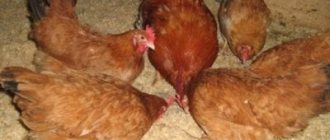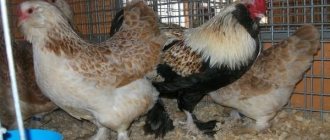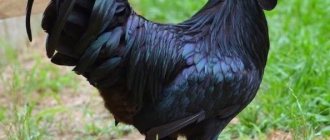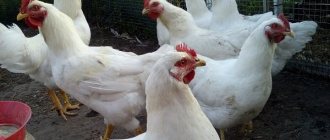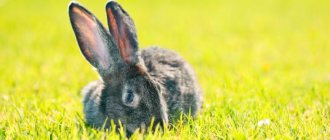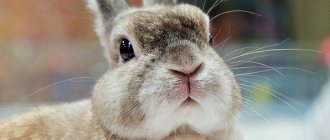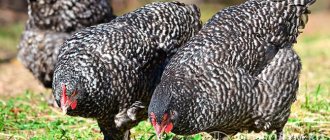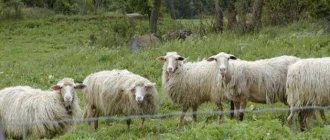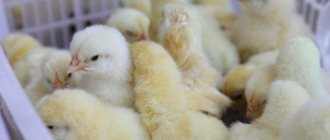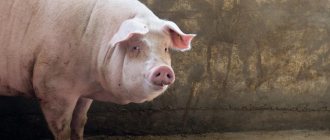Breeds
4657
no comments
The white giant rabbit is one of Flandre's relatives. The white giant is an albino with red eyes, a popular meat-skin breed in Russia. The article contains details about the White Giant, a little about popular and rare breeds of pure white rabbits.
Within the White Giant breed, two selection groups (offspring) are known.
Offspring is a zootechnical term, not a dirty word, see crossbreeding. The term denotes a split within one breed into two or three groups adapted to different breeding conditions. Look about giants, or more precisely about the breeding of German and Russian white giants.
- The white giant is a German offspring (since 2012 the breed has not been maintained in its pure form).
- The White Giant is a Russian spawn. In our article the story will be about the domestic selection of this breed.
Photo. Rabbits White giant of domestic selection
History of breed selection
White giant, a breed of albino rabbits. As a result, scientists in Germany and the USSR, using different methods, obtained a breed with the same name “White Giant”, outwardly almost indistinguishable rabbits, albinos with red eyes.
Albinism is a genetically determined absence of the melanin pigment in a rabbit's body. The absence of melanin in the body gives:
- wool - white;
- the pupils of the eyes are red or blue;
- claws - colorless coloring.
For what purpose were breeds of albino rabbits bred?
White color has long been a fashionable color, which explains the large number of identical breeds in different countries. Genetic mutation - albinism is caused by breeders using random or controlled inbreeding. The result is confirmed by purebred crossing. The peculiar coloring unites the albino breeds and makes them indistinguishable upon a quick examination. The white giant rabbit breed is very similar in appearance to other white breeds. Rabbits are distinguished by body type, weight standard, and eye color.
The White Giant breed is supported in 7 breeding breeding centers in the Russian Federation (Moscow - 2 breeding stations, one each in Perm, Krasnodar, Tula, Ulyanovsk). The fate of the loudspeaker in Tatarstan is unknown.
Reviews from rabbit breeders
From my own experience, I can say that NZKs do not justify themselves as broilers when bred for meat. In terms of early maturity, they are much inferior to the Caliphs, NZB and Pannons. Winter weight gain is very dependent on feeding and living conditions. This winter, all the three-month-old young animals turned out to be small and skinny; none even reached 2 kg. In the summer, the offspring from the same parents normally grew on the grass. Galina, 64 years old, Donetsk region
Keeping New Zealanders only makes sense for interbreed crosses. If you cover a female NZK, for example, with a Californian, then the hybrid offspring in the first generation turns out to be significantly superior in productivity to both parent breeds. Same with NZB. We mixed with Flandre and the result was excellent. Ivan, 41 years old, Izhevsk
Female rabbits of New Zealand breeds are quite fertile, producing 9-12 rabbits per litter, while having good maternal qualities and high milk production. Rabbits grow especially actively at an early age. They are most often left under the female for up to 60-70 days, and then slaughtered for meat. In matters of maintenance and nutrition, they are very unpretentious. To get the most from these rabbits, it is better to raise them using the Mikhailov method. Maxim, 50 years old, St. Petersburg
The most beautiful New Zealand rabbits cannot leave anyone indifferent. They are not only easy to breed, but also have high quality characteristics.
Breed standards
- The body is elongated, the bones are strong (tribe), thin (for fattening),
- The head is round, the ears are light (15–18 cm), erect;
- Chest, girth more than 37 cm (tribe), less than 36 cm (fattening), a dewlap is characteristic;
- The back is long, medium wide, straight.
- The sacrolumbar part is wide (breeding, or fattening), narrow (marriage).
- The croup is wide and rounded.
- The legs are long, straight, strong and not thick.
- Eyrisomny type of constitution (simply athletic body type) - suitable for breeding.
- The rabbit has a mesosomal build (medium athletic build), thin bones, and is suitable for fattening.
- A white giant with a leptosomal body type is sent for fattening.
Preservation of the White Giant breed
Since rabbits can very quickly lose their breed qualities, if there is incorrect breeding classification, errors in feeding and maintenance, you need to constantly be on the alert and ensure that the breed is kept clean. They monitor the most obvious deviations from standards, which are easy to detect even for a non-professional. They look at two main parameters:
- skin defects (fur is a genetically fixed characteristic of the breed),
- slaughter weight (a decrease in the weight of a rabbit after slaughter is evidence of the degeneration of the breed).
Specific examples of deviations from the White Giant breed standard:
- uneven hairline;
- the appearance of fluffy fur (non-standard fur color);
- reduction in early maturity and slaughter yield in 90-120 days by more than 56-59%.
If the live weight of a rabbit before slaughter is 5.1 kg, then the carcass should not be less than 3.0 kg. this is a signal that the breed is reducing its potential.
Productivity
The large weight of white giants is the main reason that such animals are bred to produce valuable dietary meat. The yield of rabbit meat from one head, 65 days old, is 47%. If proper feeding is observed, this figure increases to 59-60% by the 275th day of the animal’s life. At the same time, livestock meat products are in high demand due to their delicate texture and excellent taste.
There is a high demand for the skins of this breed of rabbits
But of course, such rabbits are raised not only for their meat productivity. There is a high demand for the skins of this breed of rabbits. They are distinguished by high density, silkiness and softness of the pile. A wide range of different clothing items and accessories are produced from such raw materials.
Reference. According to the results of the research, it was revealed that on an area of 100 sq. mm of rabbit skin grows an average of 18-22 thousand hairs. At the same time, there are about 20-23 downy hairs for each core villus.
Cages for the White Giant, sizes
This breed needs a large cage space; a wooden cage is recommended. It is better to do it yourself at home. You create the structure of the cage yourself. It is important to know the floor dimensions. This is the most important indicator; the larger the breed, the larger the cage. On the other hand, unreasonably large cages are an overconsumption of building materials. For large breeds (Gray giant, White giant, Flanders, Soviet chinchilla), with an average live weight of 6–8 kg, it is necessary to make the following sizes:
- length 1200–1300
- width 600–700 mm,
- height 35-40 cm
Or, according to technological design standards, the floor area is calculated based on the minimum requirement of a large rabbit - 0.2 m2 per kg of animal body weight. If the rabbit weighs 6 kg, then the floor area of the cage will correspond to 1.2 m2.
It is necessary to periodically maintain cleanliness in the cage. Cleaning cells 2-3 times a week. Every six months the cells must be disinfected by whitewashing with lime.
Content
For breeding such rabbits, especially spacious cages are used. They should have a simple design that will make daily cleaning as easy as possible. The floor of such a cage must be made of solid material. You should also immediately install a large drinking bowl and feeder inside.
The enclosure must be divided into two halves. The first one is open. The animals will walk in it during the day. The second half is a shelter closed on all sides for females and young animals.
It is recommended to keep both young and adult livestock exclusively outside. Summer heat and mild winter frosts allow animals to quickly harden their bodies, which significantly reduces the likelihood of illness. Animals should only be moved indoors if the temperature drops below -20 degrees. Such air cooling is already fraught with frostbite.
Keeping young animals
As for keeping baby rabbits of this breed, they should be handled with extreme caution during inspection and transportation. Their bones and spine are fragile and can be easily damaged. In addition, babies gain weight much faster than their bone tissue can strengthen. Therefore, if a baby rabbit is frightened, he may break his leg by making a careless sudden movement.
Albino baby rabbit
Also, it is worth noting that young animals should be placed in separate cages already at 2-3 months of age. Rabbits experience rapid puberty and, if they are not seated in a timely manner, they begin to mate indiscriminately. And at such a young age, it leads to a slowdown in growth, and also implies a high probability of developing pathologies in the offspring.
Breeding the white giant breed
The white giant matures early enough for mating and breeding. This procedure will not cause any difficulties. This is one of the best breeds for breeding. Those who breed white giants consider female rabbits to be responsible mothers with good fertility. One litter - up to 8-9 rabbits. Read about female pregnancy and litter here. Female rabbits are usually placed with males at the age of six months. For breeding, large representatives are selected, without defects, defects, and with strong limbs. Mating usually lasts a couple of hours, sometimes faster. After 5-6 days, a repeat control procedure is performed. In a situation where the female does not allow the male to approach, therefore, fertilization has already been done. Baby rabbits, when they are 2 months old, are separated from their mother and begin to feed on their own.
High maternal instinct in females
The pregnancy of white giant females lasts 30-32 days, after which they give birth to 7 to 15 babies, although the birth of 9 rabbits is considered optimal. Rabbits are very good mothers and never eat their babies.
This breed of rabbit differs from most others in that the females produce a lot of milk, which is 4 times higher in nutritional content than cow's milk. For this reason, rabbits can live in the same cage with their mother for up to 2 months, and adding dry food to their diet is not required.
Due to the increased work of the mammary glands, which produce up to 250 ml of milk per day, they wear out greatly. After 3-4 births, a female white giant may develop mastitis, which is a characteristic disease of this species of animal.
Rabbits that have stopped feeding should be palpated daily and if hardening appears in the chest area, immediately contact a veterinarian.
With timely treatment, the female quickly recovers, but an advanced disease can lead to the death of the animal.
Features of feeding giants
The white giant grows quite well on regular feed. The basis of the diet is crushed grain or mixed feed. About fattening rabbits.
- Barley, grain crops (pearl barley, barley) cereals. In the form of grain, it is a valuable fodder crop rich in vegetable protein and carbohydrates in the form of starch. In the structure of the diet of fattening rabbits, up to 23% is from other types of food.
- Wheat. Grain contains protein, carbohydrates, and fats. Valuable fodder crop for rabbits. In the structure of the diet of fattening rabbits up to 20%
- Sunflower cake. They are seeds after squeezing sunflower oil out of them. In the structure of the rabbit's diet it accounts for up to 13%.
- Bran. A coarse product of grain processing, rich in nutrients. In a rabbit's diet, this product can be up to 10% of the total diet.
- Alfalfa flour, in the form of granules. Can be replaced with fresh alfalfa hay. For rabbits it is used as a vitamin supplement and as a fiber-rich product. The structure of a rabbit's diet contains up to 34% of hay or alfalfa pellets.
Feed additives for the diet of giant rabbits
You can read about feed additives that are registered in Russia, here are some that are not registered or the most common.
- Chalk. Source of calcium, potassium, phosphorus, sodium, silicon. Used to normalize calcium levels in fast-growing animals, to prevent rickets, dystrophy, and bone deformations. Its amount in the diet is small, no more than 0.5%.
- The white giant, despite the fact that it is a herbivore, eats fish meal well, rich in macro and microelements. Its content in the diet should not exceed 1%.
- As a desirable substance, feed yeast is added - a source of B vitamins, amino acids and other useful substances.
- Premix (BVMK or BMVD) protein-vitamin-mineral concentrate or supplement. Several types are produced for rabbits at home: “Ushastik” and “Zdravur”. For rabbits, the farm produces premix brand P-90 and others. They are mixed into the feed in a certain ratio, indicated on the packaging.
- Table salt. In small quantities it is necessary as a trace element and to improve the palatability of the feed.
Choosing the right rabbit
Despite the fairly strong immunity of baby rabbits, adult animals are susceptible to various diseases and must be regularly vaccinated, as well as periodically undergo anthelmintic measures.
If you decide to set up a home mini-farm and start breeding white giants, then try to purchase already grown-up representatives of the breed. Until the age of three months, only an experienced specialist can distinguish males from females, and when buying at the market, you can buy a “pig in a poke.”
It is best if the rabbits are 4 months old at the time of purchase and begin to enter puberty.
Make sure that all rabbits are dewormed and have all the necessary vaccinations, including those associated with myxomatosis and VGBV. Remember that each animal brought from a separate farm may have pathogens of various diseases on its skin. Therefore, be sure to place the rabbits in separate cages for several days, ensuring quarantine measures.
White giants, rabbits of famous breeds
There are about twenty breeds of white rabbits in the world. Not color varieties that meet the standard, but white albinos, which were bred by fixing the albinism mutation. The main breeds familiar to Russian, Ukrainian, and Belarusian rabbit lovers are listed below.
New Zealand white breed of giant rabbits
Read more about New Zealand rabbits.
Photo. New Zealand White (NZB) rabbit. Weight 4.1 - 5.4.
Hungarian rabbit White Pannon
About Pannon rabbits, find out if they are a hybrid or a breed or a line, or maybe a cross? One of the differences between the pannon is that these rabbits have a skin that fits tightly to the body. To do this, take the skin of a Pannon rabbit and a white giant (for example) in the back area. Pannon is very good for fattening, but I would not recommend it for keeping in Russia. The reason is the lack of methodological support for the breed. It's easy to run into charlatans.
Photo. Hungarian rabbit is a white giant with red eyes. See more details here
Vienna white, albino rabbit
Read about the Vienna Blue and its albino sibling. In fact, these are the same breed, just different colors. Unlike many other albino breeds, he has blue eyes. There is also a wild color (agouti) of the blue Viennese rabbit.
Photo. Viennese white rabbit. Albino with blue eyes. Weight 3.5-5.25 kg.
Turkish giant Angora. white albino giant
About the Angora breed group, especially about the specific skin diseases that the Angora rabbit suffers from.
Photo. White giant from Turkey, weight 5.5-12.0 kg
Czech White, aka Czech Albin
Photo. Czech Albin or Czech White. Albino with red eyes, weight 4.0-5.0 kg
French Blanc de Bousquet albino giant rabbit
Photo. Blanc de bousquet. White giant from France. Weight 5.0-7.0 kg
Care
New Zealand rabbit: description of the breed of red and white species
The animals are unpretentious in their care, but purely physically, giant rabbits will not be able to live in cramped cages. This is perhaps one of the significant disadvantages of the breed. Otherwise, the conditions of detention are no different from those of fellow tribesmen. It is recommended to place the cages in well-lit places where there are no drafts and a consistently positive temperature.
Note! On hot days, animals should have the opportunity to hide in the shade.
Feeders in cages are installed at the height of the smallest inhabitants. There are no special nutritional requirements: in the summer it is concentrates and dried greens, and in the winter it is hay and mixed feed. From time to time, tree branches must be included in the diet.
Cages for keeping large rabbits
